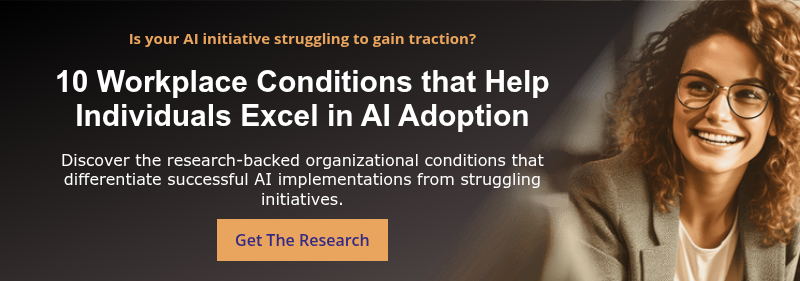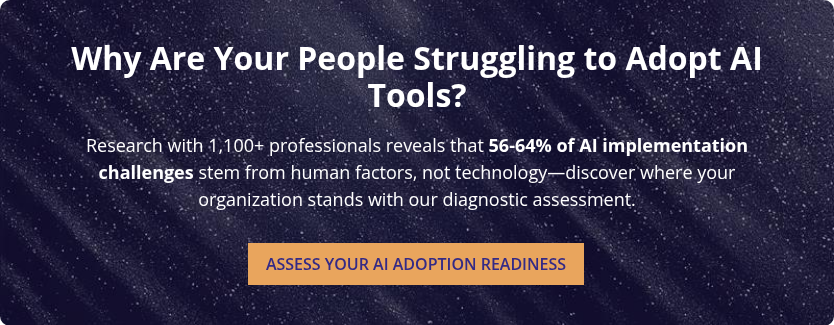
What is AI Integration?
AI integration is the process of embedding AI technologies into an organization’s systems, processes, and workflows. The goal of AI integration is to enhance business efficiency, drive automation, and improve decision-making—and there is a wide range of applications to achieve these goals.
For example, machine learning models support email automation or spam filtering, while natural language processing powers customer service chatbots to triage queries or helpdesk tickets. Predictive analytics tools can even calculate a client’s credit score or identify market trends to support research and development initiatives.
Regardless of the industry you operate in, there are bound to be areas you want to integrate AI into. When implemented successfully, the benefits of those integrations are far-reaching.
What Are the Benefits of AI Integration?
AI supports organizations in carrying out a wide range of tasks. As a result, sustainable AI integration leads to a wide range of benefits, including enhanced efficiency, better-informed decision-making, and higher performance.
That’s why corporate investment in AI has skyrocketed in recent years.
 Let’s take a closer look at how AI could improve your organization:
Let’s take a closer look at how AI could improve your organization:
Increased operational efficiency
One of the most obvious benefits of AI integration is that AI-powered tools rapidly automate repetitive tasks. AI automation enables employees to ditch time-consuming routine tasks and focus on more strategic activities or high-value tasks instead.
This not only increases productivity but also makes workflows more efficient. AI-powered tools have the power to streamline processes and workflows. In doing so, you’ll significantly reduce the cost of business operations.
Improved data capability
To harness the power of big data, your organization needs access to effective AI tools. Big data comprises huge volumes of both structured and unstructured sources of information. No organization has the time or resources to process that data manually.
AI tools can analyze vast amounts of data quickly, identifying trends and actionable insights that might not be visible to the human eye. This adds an entirely new dimension to your organization’s ability to holistically forecast market movements and adapt to trends.
AI tools can also help organizations improve their data management processes, making them more structured and efficient. This allows organizations to prove more easily that they’re following industry regulations or legal requirements.
Enhanced decision-making
Armed with AI tools, you can generate data-driven insights to support your organization in making strategic decisions faster.
For example, AI functions like advanced analytics empower your organization with pattern recognition to forecast market trends and user behaviors. Using these forecasts, leaders can develop the confidence they need to pivot strategy or redirect resources.
Seamless customer experience
AI integration isn’t just about improving internal processes for your organization. It also improves customer satisfaction levels.
One of the top customer service applications of AI is personalization. AI-driven solutions facilitate bespoke interactions and faster response times.
For example, when a customer opens a ticket with a helpdesk, AI-powered chatbots can instantly retrieve their past interactions, purchase history, and previous support inquiries. This allows the chatbot to provide relevant responses based on the customer’s unique needs without requiring them to repeat information.
AI tools can also generate automated email journeys with personalized content based on customer behavior so that they always receive up-to-date information tailored to their shopping experience.
By offering a more bespoke service to customers, AI supports your organization in establishing stronger connections with people.
Optimized resources
AI tools have the power to identify workflow inefficiencies—and subsequently offer suggestions on how to improve those processes.
This supports operational efficiency and enables improved resource allocation and workforce utilization. You can reduce resource waste and ensure your human resources are focused on high-value tasks instead of tedious tasks that could otherwise be automated.
What Are the Challenges of AI Integration?
Although the benefits of AI integration are far-reaching, there are some fundamental challenges that go hand-in-hand with AI integration—and they all stem from adoption.
User proficiency, resistance to change, technical implementation, and trust all have the power to impact adoption among the people impacted by the new technology. Without that successful adoption, your organization won’t sustain the benefits of integration.
 Let’s take a closer look at these challenges:
Let’s take a closer look at these challenges:
User proficiency
AI technology is evolving quickly. As a result, many people in your organization will experience an AI learning curve—even if they’re relatively tech-savvy.
According to Prosci research, 38% of employees say that difficulties in training and adapting to new technologies like AI presented them with a major challenge. If that challenge goes unaddressed, AI integration issues often slow processes down rather than speed them up.
That’s why you need to place equal emphasis on the technical and the people sides of change. Those impacted by the new technology need to be prepared, equipped and supported to develop the proficiency they need to use AI.
Resistance to change
The people in your organization impacted by the new technology may be hesitant to embrace new AI systems.
A lack of understanding of the reasons behind the decision is the number one reason for employee resistance to change—followed by a hesitancy to embrace change within their role, and fear of job displacement.

According to one recent survey, 36% of workers now fear AI will make their jobs redundant within the next five years. Meanwhile, 57% of respondents say they expect AI to reshape their role.
Understanding the root causes behind resistance allows you to identify the most significant barriers to change and remove them, preventing future resistance.
Technical implementation
Integrating AI into existing systems is complex, and organizations often have problems integrating AI tools into existing processes, tech stacks and workflows.
The issue here is twofold.
On the technical side, your organization might find it challenging to align clunky legacy systems with new AI tools to create a unified tech stack. Disjointed implementation could inhibit enterprise-wide adoption—which hurts your initiative’s sustainability.
But there’s also the people side to consider.
A successful technical implementation requires collaboration between multiple teams and feedback loops to identify issues early. Without an effective strategy to manage that collaboration, important elements can get lost in translation.
Trust and reliability
Issues of AI trust and reliability are often front-page news, and they are likely to have impacted your workforce.
Prosci research indicates employees are concerned about the accuracy and reliability of AI outputs, and about data management and the ethics of using AI.
Change management acknowledges those concerns, allowing you to prepare, guide and support the people affected. It also helps you demonstrate how AI integration simplifies workflows while elevating your organization.

Strategies to Achieve Successful AI Business Integration
Change management’s human-centric approach enables you to better engage with impacted people. This allows your teams to develop a deeper understanding of the need for AI integration, guides them through the change process, and supports people to adopt new ways of working.
Here are three strategies to integrate change management into your upcoming AI initiative:
1. Engage with employees early
We’ve already acknowledged the inherent skepticism many employees may have toward AI. To address this, it’s imperative to develop a strategic communications plan that educates employees on the value of AI, its tangible benefits, and the specific ways it will reshape their roles. A proactive, transparent approach will build trust, foster engagement, and position AI as an enabler of growth rather than a threat.
The Prosci ADKAR® Model is a proven approach for driving employee engagement throughout any change process. As one of the two foundational models of the Prosci Methodology, ADKAR outlines the five key outcomes individuals must achieve for successful change: Awareness of the need for change, Desire to participate and support it, Knowledge of how to change, Ability to implement new skills and behaviors, and Reinforcement to sustain the change over time. By leveraging ADKAR, organizations can systematically prevent and mitigate resistance, build commitment, and ensure AI integration is both effective and lasting.
Prosci ADKAR Model

Here’s how to apply our ADKAR Model in the context of an AI integration project:
- Awareness – Set up meetings and workshops to directly communicate why AI is being integrated and how it benefits each team.
- Desire – Address fears by highlighting how AI enhances the roles of each impacted person rather than replacing them.
- Knowledge – Provide AI training that’s tailored to different user groups. This will maximize proficiency and have a positive impact on adoption.
- Ability – Offer hands-on workshops and pilot programs that enable people to practice concepts and build confidence in their skills.
- Reinforcement – Recognize early adopters of new AI tools and measure adoption success.
With our ADKAR Model, you can improve engagement levels and better anticipate the root causes of barrier points. This enables your organization to prevent potential sources of resistance and move the change forward—gaining commitment from your people along the way.
2. Develop a clear change management strategy
Successful AI integration requires a clear change management strategy that outlines how a new AI project will be communicated, the necessary training, and how to engage with the people impacted by the change.
The Prosci Methodology helps you achieve just that.

A core part of the Prosci Methodology is the Prosci 3-Phase Process. The three phases are: Phase 1 – Prepare Approach, Phase 2 – Manage Change, and Phase 3 – Sustain Outcomes.
Here’s how they support you in defining and applying your change management strategy:
- Phase 1 – Prepare Approach – This phase enables you to define the success, impact, and approach of your AI integration project.
- Phase 2 – Manage Change – This phase supports you in creating a detailed plan to prepare, equip and support impacted people. You then enact that plan, tracking performance and adapting as required.
- Phase 3 – Sustain Outcomes – This phase enables you to review performance, implement strategies to ensure sustainment, and transfer ownership and responsibility for maintaining AI tools and processes to operational teams.
This structure helps change practitioners plan and execute AI integration systematically, ensuring that all aspects of change management are addressed.
3. Use an iterative and flexible approach
Given the fast-moving nature of AI technology, organizations must be prepared to adapt quickly to new tools and processes. A structured, iterative approach provides the necessary flexibility, allowing teams to test, refine, and optimize AI solutions as they are implemented.
Choosing this approach gives employees the time and space to engage with new tools while creating empowering feedback loops that help identify necessary adjustments. By continuously engaging impacted employees, organizations can address concerns, refine processes, and drive adoption more effectively.
To support this adaptability, your change management plan must be dynamic, incorporating milestones aligned with key deliverables. This ensures teams have the agility to make adjustments as needed, reinforcing both employee engagement and successful AI integration.
The Prosci Methodology is inherently flexible. It equips change practitioners with the tools to tailor change management plans to the unique circumstances of each project. This adaptability is essential in the context of AI, where rapid advancements demand a responsive and proactive change strategy.
Start AI Integration on the Right Foot
AI is a game-changer, but true transformation goes beyond technology—it requires people, processes and strategy to work in alignment. Integrating AI into legacy systems and workflows presents challenges, from tech stack limitations to workforce resistance. Without a structured approach, adoption suffers.
The Prosci Methodology helps organizations succeed in AI integration and achieve the results they set out to. With a clear roadmap, leadership alignment and strategies for engagement you can drive the adoption of AI tools, prevent resistance, and achieve lasting success.
AI is the future. Let’s ensure your workforce is ready to embrace it.





